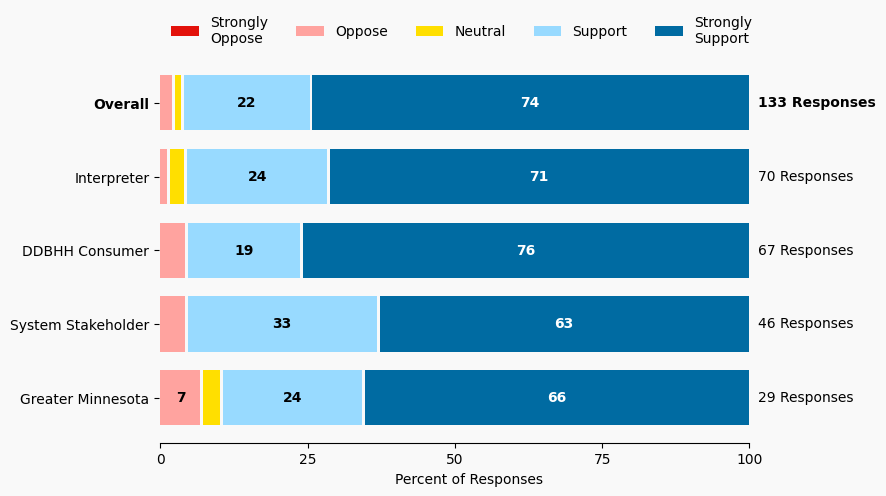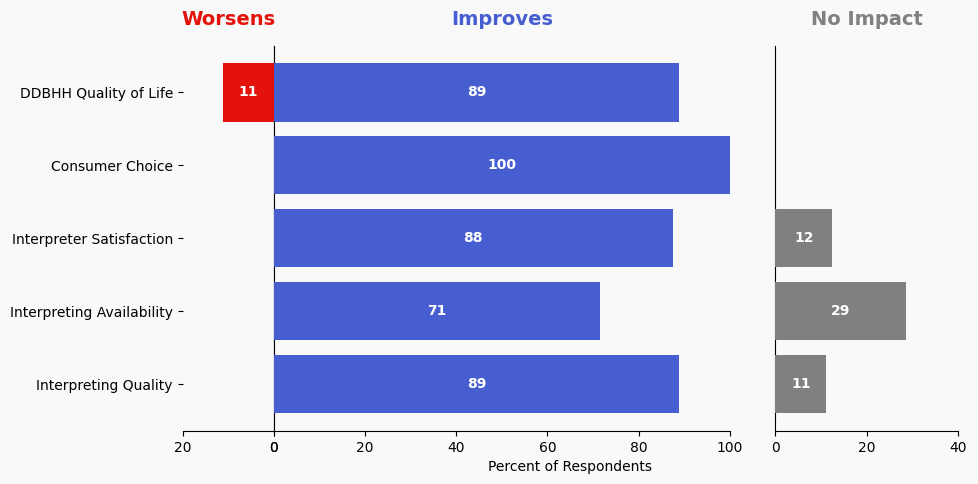56 Educate Health Care Systems on the Best and Inadvisable Uses of VRI
Issue: Lack of standardization on VRI in healthcare settings
Proposed Solution: As VRI services in healthcare settings are non-standardized nor regulated, a coalition, with the Minnesota Department of Health, Minnesota Hospital Consortium and State Services as the co-leads for this project, will provide education and outreach to all medical providers regarding VRI standards and best practices. Using NAD resources and other sources of information for VRI, provide clear and direct information to administrators regarding the need, while also providing explicit instructions for hospital staff to use VRI effectively. Patient choice for on-site interpreter requests are still to be honored. Instructions to hospital staff reinforce the ADA guidance that DDBHH people instruct the providing entity on their communication needs. Contact information for requesting an on-site interpreter is also included.
Expected outcome: DDBHH patients will gain better health outcomes due to better communication access.
Who is impacted: Consumers, interpreters, health care systems
Timeline: 6 months
Note: The Minnesota Hospital Consortium is a valuable partner for this endeavor.

Summary of Support Image Description
The stacked bar charts show how respondents rated their level of support and the total number of responses. The percentage for the five support levels is shown from left to right: Strongly Oppose (Dark Red), Oppose (Light Red), Neutral (Yellow), Support (Light Blue), and Strongly Support (Dark Blue).
Respondents may identify with multiple subgroups. The overall level of support is:
Overall
Strongly Oppose: 0%
Oppose: 2%
Neutral: 2%
Support: 22%
Strongly Support: 74%
Click to see the detailed image description for each subgroup.
Interpreter
Strongly Oppose: 0%
Oppose: 1%
Neutral: 3%
Support: 24%
Strongly Support: 71%
Greater Minnesota
Strongly Oppose: 0%
Oppose: 7%
Neutral: 3%
Support: 24%
Strongly Support: 66%
DDBHH Consumer
Strongly Oppose: 0%
Oppose: 4%
Neutral: 0%
Support: 19%
Strongly Support: 76%
System Stakeholder
Strongly Oppose: 0%
Oppose: 4%
Neutral: 0%
Support: 33%
Strongly Support: 63%
Overview of Respondents Opting for In-Depth Solution Analysis
After indicating their support level, 4% of the 133 respondents opted in to further assess whether the solution would worsen or improve on five metrics. Of the opt-in reviewers (6 respondents), 100% supported the solution, 0% were neutral on the solution, and 0% opposed the solution.
The remaining 127 respondents did not opt in to further assess the solution. Of these people, 96% support the solution, 1% were neutral on the solution, and 2% opposed the solution.
Reviewer Evaluation of Solution Effectiveness

Solution Effectiveness Image Description
The stacked bar charts show how respondents assessed the effectiveness of this solution based on five metrics. For each metric, the percentage of respondents is shown from left to right: Worsens (Red), Improves (Blue), No Impact (Gray).
DDBHH Quality of Life
Makes It Worse 11%
Makes It Better 88%
No Impact 0%
Interpreter Satisfaction
Makes It Worse 0%
Makes It Better 87%
No Impact 12%
Consumer Choice
Makes It Worse 0%
Makes It Better 100%
No Impact 0%
Interpreting Availability
Makes It Worse 0%
Makes It Better 71%
No Impact 28%
Interpreting Quality
Makes It Worse 0%
Makes It Better 88%
No Impact 11%
Reviewer Feedback and Insights
Interpreter
Comments from Interpreters suggest that while VRI can be an important part of accessibility in Greater Minnesota, it should not be the default solution in all cases. Educating health care providers about when VRI is appropriate and when on-site interpreters are necessary is crucial. Additionally, some prefer VRI to avoid awkwardness when discussing personal medical issues with a direct report interpreter.
Deaf, DeafBlind, Hard of Hearing
Comments from DDBHH Consumers express varying views on VRI, with some finding it effective when supported by quality internet and opposing removal of VRI from medical contexts, particularly in instances of urgent care. Some comments indicate that they prefer VRI over on-site interpreting during personal medical cases. One comment suggests hiring local VRI interpreters familiar with regional sign language variations to enhance communication clarity and quality.
System Stakeholder
Comments from System stakeholders call for careful framing to ensure VRI is not overused or underused based on consumer preferences.
PREVIOUS SOLUTION
55 Educate Health Care Systems on the Need for On-Site Interpreters
Issue: Decision makers in health care settings make decisions that negatively impact the deaf, deafblind and hard of hearing community and interpreters.
NEXT SOLUTION
57 Seek or Create a Grant to Assess Medical VRI Services Statewide
Issue: Standards are nonexistent for VRI in healthcare settings
Leave a Reply